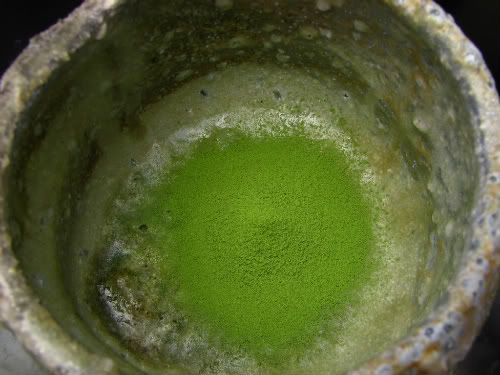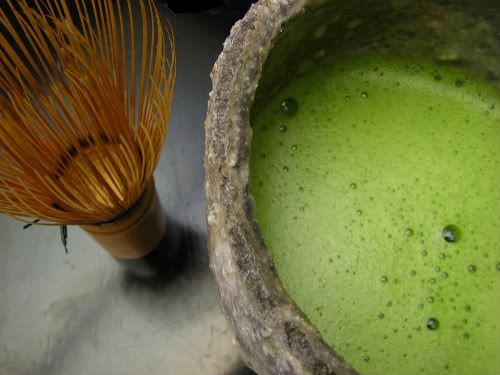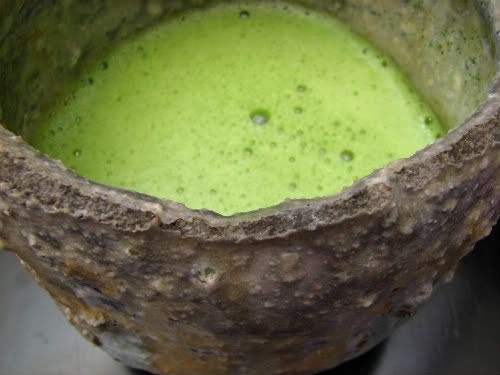A few complex issues likely involved here. Warning.... slightly boring slightly technical crap coming. If you don't care... leave now
This chawan has a very heavy build up of shizenyu (natural ash deposit glaze). It was clearly places in a "prime location" in the kiln. This is caused by the deposition of wood ash onto the surface of the piece during the firing. Wood ash contains the remnants of the minerals that the tree took up from the soil in which it grew. In almost every case I can think of, the contents of this ash, from the toxicological "leaching" viewpoint, does not contain anything of concern. So no real worries there at all.
Happily (for us potters) those minerals in the ash include a lot of CaO, Na2O, and K2O. Those three oxides are powerful high temperature fluxes (melting point lower-ers) on SiO2 (silica), the prime glass former in ceramics. All clay bodies contains significant amounts of silica (along with alumina)... so the fly ash "attacks" the surface of the clay, "steals" some silica with some attendant alumina, and forms a layer of glass...or more correctly since there is alumina present, "glaze".
This is stuff us woodfirers just love. More ash....more ash.
As ash deposits get thicker, the differences in characteristics between the shizenyu and the clay body start to become more apparent. The thicker the ash deposit layer, the higher the percentage of stuff like CaO, Na2O, and K2O relative to the SiO2 and Al2O3 (alumina) content stolen from the body in the "glass" that is formed. The properties this change in the ratios of oxides affects becomes significant in certain situations.
If you look closely at the thickest places of glass on that bowl, you'll see that there is a pattern of little "cracks" in the surface that is visible where the ash is sort of "clear". This is called crazing. Crazing is either a technical defect or an asset, depending on the context in which you find it
Crazing occurs due to a difference of the coefficient of reversible thermal expansion (COE) between the underlying clay body and the glaze on the surface. When the high COE glass "sets", it is shrinking more than the clay does. Glass is very weak in tension..... so it cracks to relieve the stress. Some of this crazing happens in the cooling kiln. Some can happen afterwards (see below).
Wood ash contains a high percentage of Na2O ........ the oxide with the highest COE of all of the oxides used in ceramics. K2O is not far behind Na2O. So the natural ash glazes tend to have an inherent tendency to not "fit" the clay bodies they are on. As the ash deposit gets thicker, the fluxes to glass former ratio goes down, thereby increasing the glass's COE..... and making it not "fit" the body as well.
Delayed crazing can be triggered by stuff like thermal shock......such as when you pour hot water into a piece. This is a part of what you are hearing. The thermal stresses of uneven expansion of the bowl as the hot water hits it are adding a little more "oomph" to the difference in size between the glass and the clay....and the glaze is crazing a bit more.
Even just soaking the clay body in water can promote a bit of extra crazing, as the filling of pores adds a tiny bit of stress to the piece.
Once the glaze has cracked up enough to relieve the stresses even when the form is hot.... the crazing (and noise) will stop.
There is an additional factor or two here........
The piece is made out of a clay that clearly contains nodules of a granitic or feldspathic rock........ those are the little whitish spots of melted "glass" you can see bubbling out of the unglazed clay on the kodai. These locations in the clay body also have a different COE than the surrounding main clay ingredients. So each little "pocket" of this melted "glass" inside the body is also tending to do the crazing thing. This too will eventually stop.
Then there is the fact that the little blobs of melting glass in the claybody can leave some small voids as they melt. If sealed by the clay around them, these voids are composed of gases evolved during the firing and trapped there. These gases (and their volumetric size) will be affected by the heating and cooling of the bowl. They can add some very tiny stresses to the body too. That can make things "move" a bit.....and create some subtle noises. These might not fully go away......but this noise is likely not what you are hearing much of.
If a bit of the melting "rock" in the clay is near the surface of the piece, it is possible that it opens up a small hollow opening into the surface. This might be the geneisis of some of the holes you are seeing in the shizenyu (or see below). These small holes can let liquid peneterate into them. This can cause some of the "sizzling" sounds you hear....like what you hear when something like an earthenware flower pot is put in water..... but MUCH less so.
As you "soak" the bowl and the pores seal up with moisture, these sounds too will go away. Are these voids a "defect" that lets tea penetrate and get trapped into the body? Yes. But this situation is common to this type of work. While as a technicality, this is not "good" from a hygiene standpoint...... countless people have ingested tea from pieces like this and have survived.
Another reason for the holes you are finding in the shizenyu can be tiny bits of wood charcoal that embed themselves in the melting glass. Eventually as the glaze sets, the bits finally burn out.... leaving tiny voids in the glaze.
Another factor is that the shizenyu glass is full of materials that evolve gases (like CO2) as the chemical reactions take place in fusion..... and those gases have not gotten out of the glass as it sets. You can see some of this tendency where the piece was broken off the wadding along one part of the lip. Some bubbles are just below the surface.... and crazing action in the glass causes the thin surface layer of glass to break, leaving a little hole. Some of these can show up in use as they eventually break. More potenntial for a bit of "sizzling".
The amount of "hazard" to the user that this kind of piece presents is really kinda' minimal. Might you ingest a tiny itsy weenie bit of glaze that eventually breaks off a thin bubble edge? Yes. But the size of that piece is going to be so small as to be un-noticable and will do no damage to you as it passes through. You eat worse stuff in the food you likely eat.
BTW...... Anyone who is concerend about the toxicology of using ceramics might want to take a serious look at the potential toxicology of the stuff you get out of stuff like plastic sports bottles (particulary women)!
A modern ceramic engineer who was used to evaluating restaraunt wares would have standards that say this bowl (and almost all woodfired shizenyu type pieces...and raku pieces, and so on) has loads of defects. But it is those exact "defects" that make a lot of the work we love so very distinctive. These defects are the trade off for the "wabi-sabi" type aesthetic effects.
This is a very special bowl visually. Because of the characteristics that make it so special, it is also a tad "fragile". At a technical level, if compared to that ceramic engineer's "perfect" food-ware bowl, it might have a more limited life expectancy due to the crazing and lumps of glass in it. It likely is a tad weaker in MOR (clay body strength) than the engineer's ideal, due to the nature of the body. It is a "soft" glass (as all shizenyu is)....it can slowly change with use over time (which most chajin consider an asset....not a defect). And so on.
But it is beautiful!
You are right in your observation that it should get special care. The warming (washing) process that is a part of Chanoyu is a good step in the care of this bowl. As is adding some cold water to the kettle before using the water. Don't knock it around...... hold it close to the tatami. Like you do with the chasen each time you use it, inspect the bowl and keep track of stuff like tiny bubbles ready to break. Break them deliberately, and polish the edges (wet 220 grit wet-dry silicon carbide paper) if you have to.
Cherish it........it was a difficult birth. It deserves to live. Accept it as it is. If it eventualy dies, that is part of the natural cycle of life too.
best,
..................john
PS: NICE bowl!


